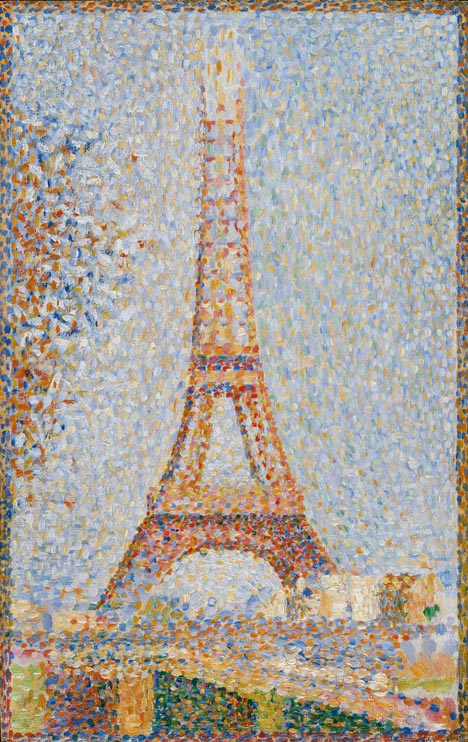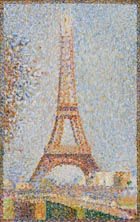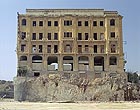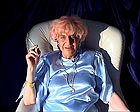
translated and summarized by: Liz Wollner-Grandville,
English summary February 22 - 27
Schirn Kunsthalle Frankfurt
Georges Seurat – Figure in Space
04.02.10 – 09.05.10
In the Pixelfield of Modernism
As desensitized and unfailingly well-informed people, we are not easily irritated by classic modernist paintings. As long as they don’t not involve George Seurat. Maybe because we walked past his works much too fast in the Metropolitan or in the National Gallery in London. Or maybe because Seurat’s pixel-paintings on posters and in motion picture animations have already destroyed all feeling for them.
At the Frankfurt Schirn Kunsthalle the work of Seurat, who is considered the mastermind of pointillism, surprise with their remarkably small dimensions. “La Tour Eiffel” (1889) is no larger than a legal notepad. Seurat’s drawings, together with the typical impressionist themes of leisure-outings to river banks, boats, sailors or fishers on small wooden tablets, create an unusually intimate exhibition that invite to stroll slowly through the exhibition.
The limited measurements of his paintings result from Seurat’s work with the – at that time - popular “Boites à Pouce” (small paint box). With reference to the Croquis used at the Ècole des Beaux-Arts, Seurat named his typical small sketches “Croquetons”. With their format of 16 x 25 they fit perfectly into the lid of his folding paint box and were easy to carry around; even if the colours had not yet dried. Seurat frequently painted directly onto a wooden tablet without applying a white grounding. Numerous sequences of the exhibition “Figure in Space” shown in Frankfurt, which was organized together with the Kunsthalle Zurich to commemorate his 150th birthday, are therefore characterized by brown background tones.
The exhibition at the Frankfurt Schirn presents some of his main works such as “Le cirque” (1890/91) or pre-studies for the famous painting “Un Dimanche à la Grande Jatte”, and thereby sets important marks. Even in seemingly incidental sketches it is easy to recognize how Seurat achieved effects of space and light with shadings and geometric elements. In the exhibition catalogue, Gottfried Boehm describes his textures as “revolutionary”. It therefore seems natural that Seurat, on the basis of the newest natural scientific cognitions about colour theory and the physiology of light, developed this analytic way to paint, which – as pointillism - extended the art of modernism in an epoch-making way. He portrayed the Eifel Tower while it was still under construction, and, as the tower was incomplete, its shape disappears mysteriously towards the upper end. The artist died of diphtheria at the early age of 31. In George Seurat’s oeuvre the image of this triumphant technical achievement and the innovation flow into one another on canvas.
By Roland Schöny
Schirn Kunsthalle Frankfurt
60311 Frankfurt am Main, Römerberg
email:
www.schirn.de
Opening hours: Tue – Sun 11 a.m. – 7 p.m., Wed – Sat 11 a.m. – 10 p.m.
Camera Austria
Walid Raad – Sweet Talk: Commissions (Beirut)
29.01.10 – 05.04.10
The wanderer through the Paris of the Middle East
The Lebanese Civil War lasted from 1975 to 1991. In 1987, Walid Raad started his photographical documentation of Beirut – neither yet knowing for what and for whom, nor seeing the possibility for presenting his photos. In the 1980’s they would have been misused for military purposes in the 1990’s for the interests of real estate and financial speculation. Raad commissioned himself with the documentation of Beirut and gave the commissions the name “Sweet Talk”. Decisive for this first time exhibition of his long-term project, which is still far from being finalized, was David Goldblatt, whose work-series also stretch over a long period of time.
Many personal aspects of Walid Raad’s flow in this presentation; something that becomes apparent in his press release, which he wrote, as well as in the way he talks about the exhibition and his works. When the Civil War broke out, Raad was eight years old and he was 20 years old as he started with the “Commissions”. Raad spent more than half of his life in a destabilized country. While this explains a lot, the implications for young Central Europeans, who only know about war from history books and news broadcasts, remain inconceivable. When Raad narrates that he encountered an invisible barrier shortly after leaving his house and literally ‘went too far’, because he had left the district of Beirut in which he was known, then one hears what he says, nods, and might think, how strange that would be, but one cannot comprehend what it really means. Questions such as “who are you?”, “what are you doing?” clearly signalized Raad to pack up his camera and walk back. And while doing so, he imagined that simultaneously with him 100 other photographers documented a part of Beirut in which they were able to move about freely. He collected their works under the name “Atlas Group”, the synonym under which Raad presented his work until now.
After some time, the radius within which he was allowed to move was extended, reconstruction work began, Beirut changed, and so did Raad's working methods. This resulted in dividing his work into 4 different groups, which do not follow a chronologic order but are determined by the chronology of his work methods.
It is very touching to see these photos and it is very impressive to have heard Walid Raad talk about his work.
By Nora Theiss
Camera Austria
8020 Graz, Kunsthaus Graz, Lendkai 1
Tel: +43 316 81 555 00
Fax: + 43 316/ 81 555 09
email: www.camera-austria.at
Tiroler Künstlerschaft /Kunstpavillion
Unexpected Turns: bankleer, Pavlina Fichta Cierna, Helmut Heiss, Nada Prija, zweintopf
23.01.10 – 06.03.10
Illusion and Reality
No matter how you look at the surveillance camera mounted on the telescope pole: the terry cloth dolls placed between the high ceiling and the roof by the Graz-based duo zweintopf remain as rigid and immovable as terry cloth objects allow. And in turn they survey the gallery space themselves and are perceived as shadow giants, when looking at them from beneath. zweintopf play with this medium, which is capable of heightening the general perception of security, in a humorous-wary way. The question comes up as to who is watching whom and why. For this year’s exhibition program “Unexpected Turns” the curators Anton Lederer and Margarethe Makovec brought together five works - all focussing on social-political questions. The main installation “Im Kommen” by the Berlin-based collective bankleer, envelops a group of fictitious participants at a public demonstration with a black cloth, whereby they not only appear as abstract protesters, but also as if they were dressed in burkas. In the video essay “Metapolitik” bankleer deal with the search for the – notably unreachable – ideal of democracy. In the two-piece work “Communism, that fallen star of political endeavour” and “Capitalism, The Show is Over”, Nada Prija visualized the expiry date of tried and tested models. Helmut Heiss seduces the onlooker to take a detailed look at the graffito discovered on the outside wall of the pavilion, whose meaning (FKKANTIFA) remains hidden, but radiates multiple prospects. The most personal contributions are Pavlina Fichta Cierna’s video portraits, such as the “Lady in Blue”, who shares her life in an artificial blue silk frock and for the length of a cigarette – from her first steps into emancipation to the horrors of being deported during the Third Reich.
By Ivona Jelcic
Tiroler Künstlerschaft / Kunstpavilion
6020 Innsbruck, Rennweg 8a
Tel: + 43 512 58 11 33
Fax: + 43 512 58 59 71
email: www.kuenstlerschaft.at
Opening hours: Tue – Fri: 9 a.m. – 12. p.m. Sat 10 a.m. – 12 p.m., Sun 10 a.m. – 12 p.m.
Kunsthaus Bregenz
Candice Breitz – The Scripted Life
06.02.10 – 11.04.10
Individuality and Mass
The video and photo artist Candice Breitz investigates the identity and individuality of our mass society by utilizing narrative structures. Breitz, born 1974 in Johannesburg, became known in Austria with her collages Ghost (1994-96) and Rainbow (1996). Both works, which deal with South Africa’s new identity after the end of Apartheid were shown in the exhibition Inclusion: Exclusion in Graz 1996. While she used to apply the techniques of over-painting and photomontage, she now works with technically advanced photo cutting for the assemblage of moving photo collages. Today, she focuses the content of her video installations on the psychological phenomenon of the lookalike in mass culture. In addition, the artist and art historian tries to sound out the political connection in the network of pop culture. For Breitz, the contemporary globalized pop culture creates a construction for collective memories, for controlled communication, emotions or senses. Projections of a fan culture emerge, which trigger the desires for a life not lived. The medial images not only manipulate the public discussions, they also introduce the private life of each individual. Breitz is convinced that dream factories such as Hollywood or MTV primarily dominate our culture. Besides her well-known large format video installations such as Working Class hero (A Portrai of John Lennon, 2006), and Him and Her (1986 – 2008) new works from the series Factum (2009) are presented in Bregenz. The artist borrowed the names for her nearly identical twin pictures Factum 1 and Factum II (1957) from Robert Rauschenberg. While Rauschenberg’s pictures were involved with the dismantling of a myth of authenticity with abstract or expressive painting, Breitz attempts to question the concept of individuality in its supremacy - in conjunction with duplicating stereotypes. Identical twins, separated from one another, are interviewed and confronted with the exact same questions for hours on end. Breitz compressed the interviews and presents them on two adjacent terminals, resembling a double portrait. While the same background and the same clothing focuses on their similarities, their individual diversity is created by their gestures and their opinions.
The two-part video installation New York, New York (2009) was produced especially for her solo presentation in Bregenz. She extends her favourite motif of the lookalike: the actors - five pairs of identical twins - play the same roles in identical stage sets, are dressed exactly alike, but are separated from one another. Matching parameters were developed for two different performances; the similarities and differences are only distinguishable through concentrated listening and watching. Andy Warhol’s famous duplicates of the icons “Elvis” and “Marilyn” are used as stage props – as an additional insinuation of Breitz’s artistic intention to encrypt a seeming individuality or The Scripted Life.
By Romana Schuler
Kunsthaus Bregenz, 6900 Bregenz, Karl Tizian Platz
www.kunsthaus-bregenz.at
Mehr Texte von translated and summarized by: Liz Wollner-Grandville


 Teilen
Teilen





